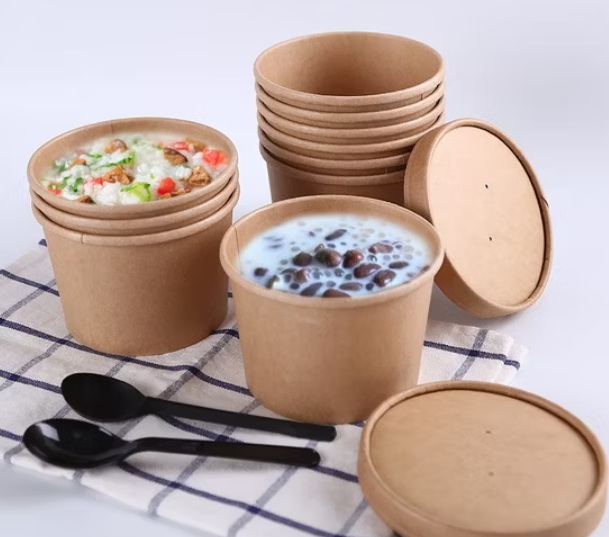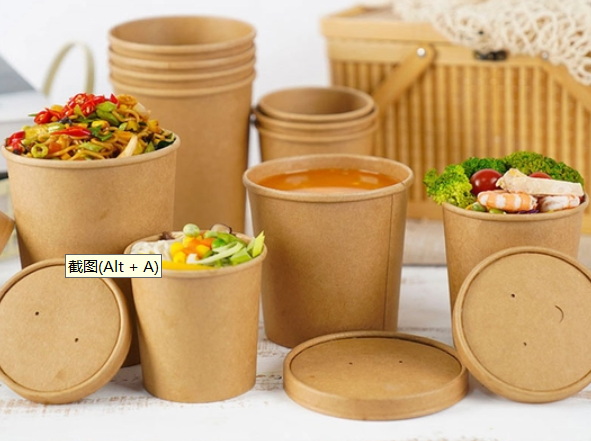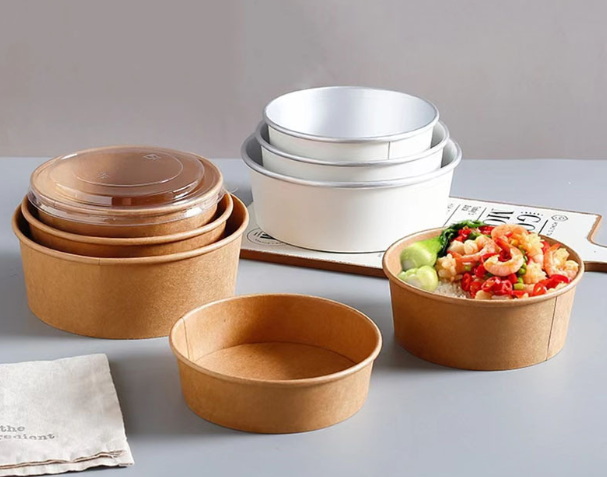
Content Menu
● Introduction to Disposable Paper Bowls with Lids
>> Key Features of Disposable Paper Bowls with Lids
● Environmental Impact
>> Production Impact
>> Disposal Challenges
>> Sustainable Materials
● Safety Concerns
>> Chemical Leaching
>> Material Safety
● Practicality and Versatility
>> Usage Scenarios
>> Customization Options
>> Common Uses of Disposable Paper Soup Cups with Lids
● Market Trends and Innovations
>> Market Growth
>> Technological Advancements
>> Environmental Impact of Disposal
● Consumer Awareness and Sustainable Practices
>> Tips for Environmentally Conscious Consumers
● Conclusion
● FAQs
>> 1. Are Disposable Paper Bowls with Lids Microwave Safe?
>> 2. What Materials Are Used to Make Disposable Paper Bowls with Lids?
>> 3. Can Disposable Paper Bowls with Lids Be Recycled?
>> 4. Are Disposable Paper Bowls with Lids Compostable?
>> 5. Do Disposable Paper Bowls with Lids Contain Harmful Chemicals?
● Citations:
Disposable paper bowls with lids have become increasingly popular as an alternative to traditional plastic containers, offering a convenient and seemingly eco-friendly solution for food packaging. However, the question remains: are these disposable paper bowls truly eco-friendly and safe for food? This article delves into the environmental impact, safety, and practicality of using disposable paper bowls with lids.

Introduction to Disposable Paper Bowls with Lids
Disposable paper bowls with lids are designed to be versatile, suitable for both hot and cold foods. They are made from materials such as kraft paper or white cardboard, often coated with a thin layer of plastic (PE) or biodegradable polylactic acid (PLA) to enhance durability and water resistance.
Key Features of Disposable Paper Bowls with Lids
- Eco-Friendly: Made from recyclable and biodegradable materials, these bowls offer a sustainable alternative to plastic.
- Microwave Safe: Many disposable paper bowls are designed to be microwave-safe, allowing for easy reheating of food.
- Leakproof Design: The lids fit tightly, preventing spills and leaks.
- Customizable: Brands can personalize these bowls with logos or designs for marketing purposes.
Environmental Impact
While disposable paper bowls with lids are often seen as more environmentally friendly than plastic, their production and disposal have significant environmental implications.
Production Impact
The production of disposable paper bowls involves the use of natural resources like trees and water. For instance, the papermaking process is highly water-intensive, with each sheet of A4 paper requiring about 10 liters of water. Additionally, the manufacturing process emits greenhouse gases, contributing to climate change[6].
Disposal Challenges
Despite being biodegradable, many disposable paper bowls end up in landfills due to contamination or inadequate recycling infrastructure. Only about 20% of paper cups and bowls are recycled, with the majority contributing to methane emissions in landfills[6].
Sustainable Materials
Eco-friendly disposable bowls are often made from sustainable materials like bamboo, sugarcane, and responsibly sourced paper. These materials have a significantly lower environmental impact compared to non-biodegradable alternatives[1]. By choosing these eco-friendly materials, we take a crucial step toward protecting our planet and fostering a greener future.
Safety Concerns
Safety is another critical aspect when considering disposable paper bowls with lids.
Chemical Leaching
Some paper bowls are lined with chemicals like PFAS (per- and poly-fluoroalkyl substances), which can leach into food, especially when hot or fatty foods are involved. PFAS exposure has been linked to health issues such as immune system suppression and certain cancers[7].
Material Safety
However, many manufacturers ensure that their paper bowls are made from food-grade materials and are certified safe for food contact. For example, BIOGreen paper bowls are certified by FDA, ISO, and SGS standards.
Practicality and Versatility
Disposable paper bowls with lids are highly versatile and practical for various applications.
Usage Scenarios
- Restaurants and Catering: Ideal for serving salads, soups, and desserts.
- Food Trucks and Events: Convenient for mobile food services and large gatherings.
- Home Use: Suitable for meal prep and reheating.
Customization Options
These bowls can be customized with logos or designs, enhancing brand visibility and personalization.
Common Uses of Disposable Paper Soup Cups with Lids
Disposable paper soup cups with lids have a variety of uses, including takeout and food delivery, convenience stores, office lunches, outdoor activities, and catering events. They are also used for food sampling and storing frozen foods[3].

Market Trends and Innovations
The market for eco-friendly disposable bowls is growing rapidly due to increased consumer awareness and regulatory pressures against single-use plastics. Innovations in materials and manufacturing processes are driving this trend.
Market Growth
The paper cup lids market, which includes lids for paper bowls, is expected to grow significantly, driven by demand for sustainable packaging solutions. The market size is projected to reach USD 51.8 billion by 2035, with a CAGR of 3.9% from 2025[5].
Technological Advancements
Advances in high-barrier paper materials and smart packaging technologies are enhancing the sustainability and usability of paper bowls. Innovations such as molded fiber lids and AI-enabled quality control systems are redefining efficiency and sustainability in this sector[5].
Environmental Impact of Disposal
While PLA-lined bowls can be composted, they require specific conditions found in industrial composting facilities. If not composted correctly, PLA can take years to break down in landfills[4]. On the other hand, bagasse bowls decompose quickly in composting facilities but may take longer in landfills[4].
Consumer Awareness and Sustainable Practices
Consumer awareness plays a crucial role in promoting sustainable practices. By choosing eco-friendly disposable bowls and supporting businesses that prioritize sustainability, consumers can contribute to reducing environmental impact.
Tips for Environmentally Conscious Consumers
- Choose Biodegradable Materials: Opt for bowls made from biodegradable and compostable materials.
- Verify Certifications: Ensure that the products are certified by organizations like the Forest Stewardship Council (FSC) or Biodegradable Products Institute (BPI)[1].
- Support Sustainable Businesses: Encourage companies that prioritize eco-friendly initiatives and sustainable practices[1].
Conclusion
Disposable paper bowls with lids offer a convenient and eco-friendly alternative to traditional plastic containers. However, their environmental impact and safety must be carefully considered. While they are generally safe for food use, the presence of certain chemicals and the challenges in recycling and disposal highlight areas for improvement.

FAQs
1. Are Disposable Paper Bowls with Lids Microwave Safe?
Yes, most disposable paper bowls with lids are microwave-safe, allowing for easy reheating of food. However, it's crucial to check the manufacturer's guidelines to ensure safety.
2. What Materials Are Used to Make Disposable Paper Bowls with Lids?
Disposable paper bowls are typically made from kraft paper or white cardboard, often coated with PE or PLA for durability and water resistance.
3. Can Disposable Paper Bowls with Lids Be Recycled?
Yes, disposable paper bowls can be recycled, but many end up in landfills due to contamination or lack of recycling infrastructure. Only about 20% are recycled.
4. Are Disposable Paper Bowls with Lids Compostable?
Many disposable paper bowls are compostable, especially those made from natural materials like kraft paper. However, certification from organizations like the Biodegradable Products Institute is necessary to ensure compostability.
5. Do Disposable Paper Bowls with Lids Contain Harmful Chemicals?
Some paper bowls may contain chemicals like PFAS, which can leach into food. However, many manufacturers ensure their products are free from harmful substances and are certified safe for food contact.
Citations:
[1] https://purpleclay.com/blogs/news/embracing-sustainability-the-rise-of-eco-friendly-disposable-bowls-with-lids-in-a-changing-world
[2] https://www.accumpackaging.com/news/are-disposable-paper-bowls-harmful.html
[3] https://www.odpack.com/news/common-uses-and-applications-of-disposable-paper-soup-cups-with-lids
[4] https://this-element.com/blogs/news/the-afterlife-of-disposable-take-out-packaging-what-happens-next
[5] https://www.futuremarketinsights.com/reports/paper-cup-lids-market
[6] https://www.sowinpak.com/news_details/The_environmental_impact_of_disposable_paper_bowls.html
[7] https://www.quitplastic.in/post/the-hidden-dangers-of-single-use-paper-food-containers
[8] https://greenpaperproducts.com/collections/compostable-bowls
[9] https://www.futuremarketinsights.com/reports/disposable-lids-market
[10] https://www.quitplastic.in/post/the-environmental-impact-of-traditional-disposable-tableware
[11] https://www.haokelaopackaging.com/info/is-it-harmful-to-use-disposable-paper-bowls-fo-69432562.html
[12] https://www.pinnaclepacks.com/blog/benefits-of-disposable-bowls-with-lids/
[13] https://www.biopak.com/hk-ch/containers-lids/bowls
[14] https://www.marketresearchfuture.com/reports/disposable-cups-lids-market-30169
[15] https://www.glamanpaperlid.com/blog/environmental-protection-paper-cup-s-impact-on-environment-and-its-sustainability_b23
[16] https://diyecobox.com/health-risks-of-paper-plates/
[17] https://www.kimecopak.ca/blogs/news/advantages-of-using-paper-bowls-over-traditional-bowls
[18] https://www.biopak.com/hk/containers-lids/bowls?p=3
[19] https://reports.valuates.com/market-reports/QYRE-Auto-19L7536/china-paper-bowl
[20] https://gmz.ltd/disposable-paper-cups-with-lids/

















